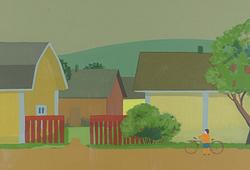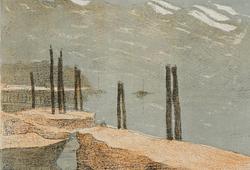Adamson-Eric
"Orientalisches motiv"
Signed Erich Adamson, Paris and dated -24. Canvas 100 x 100 cm.
Saleroom notice
Signed Erich Adamson, Paris and dated -24
Provenance
Gift from the artist to Ragnhild Bergenholm, Berlin 1925.
Stockholms Auktionsverk, Modern, 22-23 October 2013, cat. no. 1397.
Private Collection, Sweden.
Exhibitions
”Novembergruppe” non-juried exhibition in Berlin, Germany, 1925.
Prins Eugens Waldemarsudde, “Form och färg, André Lhote och svensk kubism (Shape and Colour, André Lhote and Swedish Cubism)”, 16 September 1917 – 21 January 2018.
Literature
Art Museum of Estonia, Adamson-Eric Museum, “Adamson-Eric”, 2017, mentioned in the recollections by Adamson-Eric, page 112.
“Form och färg, André Lhote och svensk kubism (Shape and Colour, André Lhote and Swedish Cubism)”, Prins Eugens Waldemarsudde, 16 September 1917 – 21 January 2018. Full colour picture, page 45, and partly shown on the dust cover.
More information
Adamson-Eric is considered one of Estonia’s most important painters and was in the 1920s and 30s one of the most well-travelled artists of the country. He studied firstly at the Charlottenburg School of Applied Arts in Berlin in 1923. However, his interest soon changed to painting which he studied in Paris from 1924 to 1926 under Charles Guérin at Académie Colarossi, Roger Bissiére at Académie Ranson, André Lhote and Moise Kisling at Académie Montparnasse, and in the studio of Vasily Shukhayev. After these studies he travelled extensively all over Europe until settling down in Tallinn permanently in 1934. His oeuvre is very broad, including paintings, applied art, and design. Uniquely for his country, his paintings are shown both in the Art Museum of Estonia as well as in a dedicated museum to Adamson-Eric located in the old town of Tallinn.
Few paintings from his early period in Paris has survived. The present painting is described by the artist himself in his published “Recollections”, within the monograph about the artist, see the literature list below, as follows: “Anyway, at Christmas I travelled to Estonia; before that I selected some of my best oil paintings to roll up and take with me. When I stopped in Berlin on my way back, I left two of them there and they were displayed at a non-juried exhibition in Berlin in 1925. One of them was probably “Serenade”, and the other “Oriental Motif.”
“Serenade” is now displayed in the Adamson-Eric Museum depicting a figure playing guitar. The present painting is much more elaborate with a sitting figure; knees extended in trousers and sandals in oriental style. The artist is creating a unique work by incorporating diverse styles of artists he has encountered in Paris, akin to the cubist-futuristic paintings by the Swedish artist Gösta Adrian-Nilsson. The head of the sitting figure is reminiscent of Malevich, whereas the rainbow-coloured shapes in his lap are orphic in the manner of Delaunay. The background in cooler colours creates an architectural stability to balance the work. However, the overall effect seems expressionistic with an amazing handling of colour by the young artist.































































